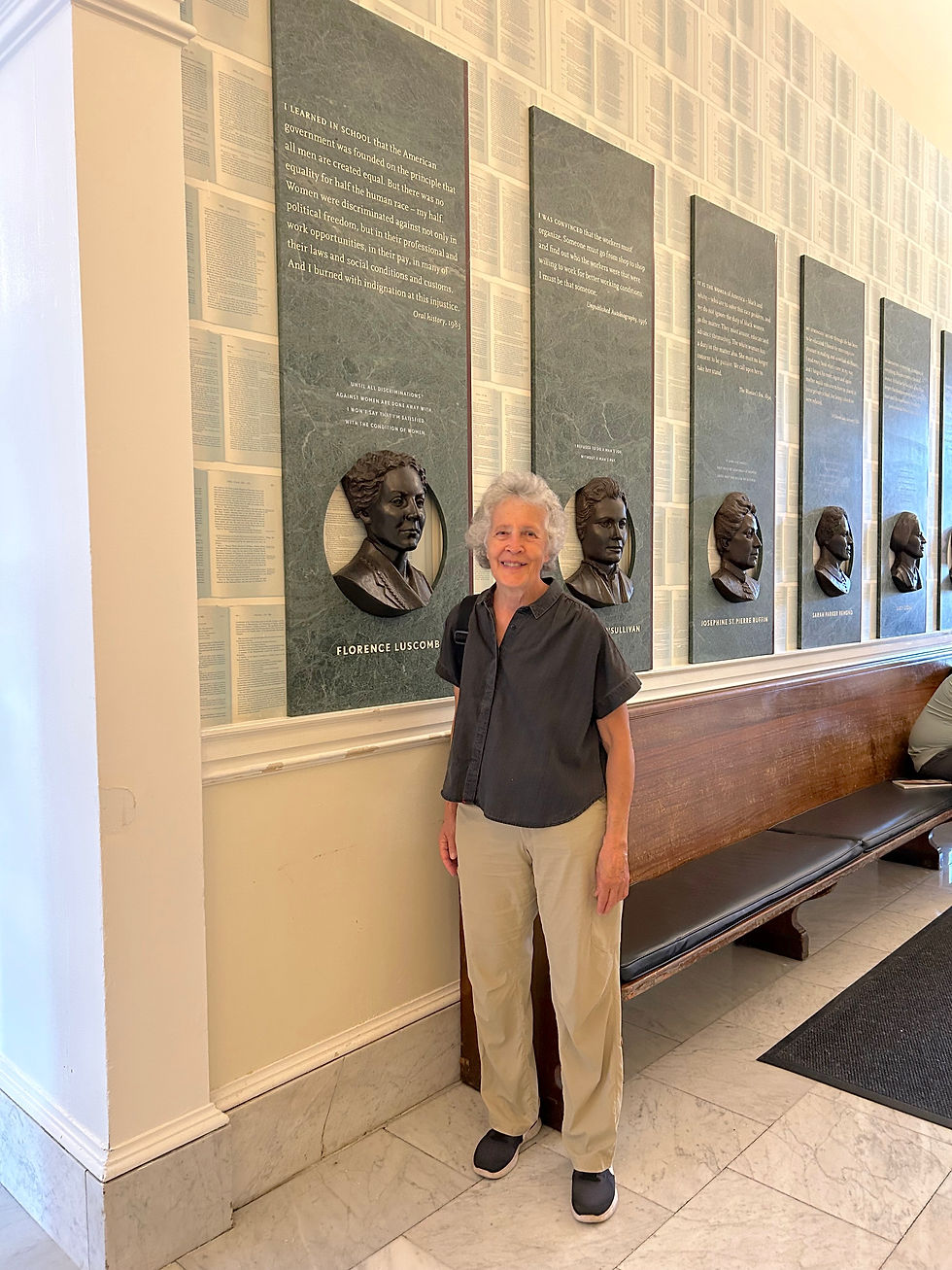Hear Us!
- Penny Colman
- Aug 23, 2023
- 4 min read

When I visit a women's history landmark, I always wonder—How did this come to be? What is its origin story? In the case of the landmark in the first image—"Hear Us!," a six-panel portrait gallery of historic woman in the Massachusetts State House—a state Senator Robert Wetmore set the project in motion after he watched the 1995 PBS Documentary, "One Woman, One Vote," and decided that the State House needed more art depicting women.
Committees were formed and funds secured and a design team assembled: Sheila Levrant de Bretteville, a graphic designer; Susan Sellers, an artist; and Robert Shure, a sculptor . Four years later, on October 19, 1999, there was a dedication ceremony, attended by the governor.
Six women who contributed to the state's social and political life are featured on 6-by-2-foot green marble panels: The image, I'm standing beside depicts Florence Luscomb, suffragist and peace activist. Next in order are: Mary Kenney O'Sullivan, founder of the Women's Trade Union League and suffragist; Josephine St. Pierre Ruffin, journalist, suffragist, and editor of The Woman's Era, the first national newspaper published by and for Black women; Sarah Remond, lecturer and abolitionist; Lucy Stone, orator, abolitionist, and suffragist; Dorothea Dix, crusader for people with mental illness and prisoners. A bronze bust, based on period photographs, is affixed inside a circle cut in the bottom of each panel. Two quotations from each woman are etched on her panel. Six government documents, each one related to one or more of the women's causes, were silk-screened in green on the back wall.
The location of "Hear Us" in a hallway is not ideal. Surveying the entire display and reading the quotations required twisting and craning my neck. I must admit I was somewhat disappoint because I love designer Sheila Levrant de Bretteville's 1989 Biddly Mason Memorial in Los Angeles (right image). There is a chapter about Biddle Mason and the memorial in my book Adventurous Women. I have also posted about it. I have written about all six 'Hear Us!" women, in particular Dorothea Dix, the subject of my first biography, Breaking the Chains: The Crusade of Dorothea Lynde Dix.

The pandemic and our continued vigilance has slowed down our women's history road trips. So, in June, when a granddaughter's high school graduation brought us near Boston, Massachusetts, Linda and I squeezed in our visit to the Massachusetts State House. We stopped at the statue located outside the State House of the Quaker religious martyr Mary Dyer sculpted by Sylvia Shaw Judson. (The statue of Anne Hutchinson, spiritual reformer, also located outside the State House was hidden by construction equipment.) Inside the building we found the Army Nurses Memorial in Nurses' Hall and viewed the poignant mural, The War Mothers. We talked about the first woman to address a legislative body—Angelina Grimké, who in February 1838, addressed a legislative committee for two hours on the subjects of slavery and women’s right to be politically active. A crowd was “thronged, wedged” inside the room “for an hour previous to the time, although no public notice was given,” reported an observer. We happened upon a display left over from Women’s History Month, a guide told us, honoring women such as Abigail Adams, Sojourner Truth, and Julia Child. It was a fruitful and fun day!
Here are the busts with the woman's name and a quote. The quote from the top of a panel is printed nearby.

"I learned in school that the American government was founded on the principle that all men are created equal. But there was no equality for half the human race—my half. Women were discriminated against not only in political freedom, but in their
professional and work opportunities, in their pay, in many of their laws and social conditions and
customs. And I burned with indignation at this injustice." Florence Luscomb, Oral history, 1893

"I was convinced that the workers must organize. Someone must go from shop to shop and find out who the workers were that were willing to work for better working conditions. I must be that someone." Mary Kenney O'Sullivan, Unpublished Autobiography, 1936
"It is the women of America—black and white—who are to solve this race problem, and we do not ignore the duty of black woman in the matter. They must arouse, educate and advance themselves. The white woman has a duty in the matter also. She must no longer consent to be passive. We call upon her to take her stand."
Josephine St. Pierre Ruffin, The Woman's Era, 1894


"My strongest desire through life has been to be educated. I found the most exquisite pleasure in reading, and as we had no library, I read every book which came in my way, and I longed for more. Again and again mother would endeavor to have us placed in some private school, but being colored we were refused. Sarah Parker Remond, A "Colored Lady Lecure," 1861
In education, in marriage, in religion, in everything, disappointment is the lot of woman. It shall be the business of my life to deepen that disappointment in every woman's heart until she bows down to it no longer. Lucy Stone, Speech to National Woman's Rights Convention, 1855


"I come to present the strong claims of suffering humanity. I come to place before the Legislature of Massachusetts the condition of the miserable, the desolate, the outcast. I come as the advocate of helpless, forgotten, insane men and women; of beings, sunk to a condition from which the unconcerned would start with rea horror.
Dorothea Dix, Memorial to the Legislature of Massachusetts, 1843



Comments